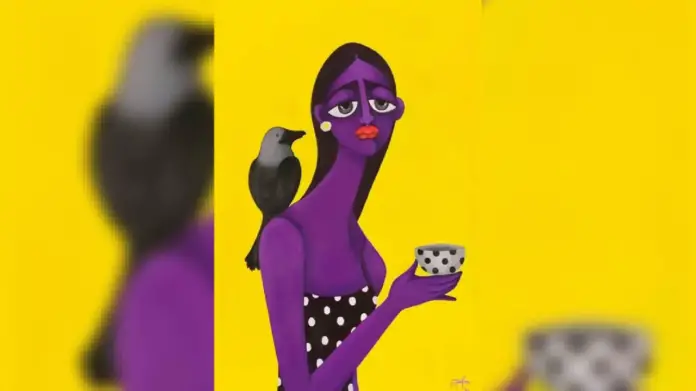My phone buzzed, and I immediately took to Facebook to take a quick scan at the comment section upon receiving a screenshot of Muniba Mazari’s recent post. The artwork had me awe-struck with its details. I must say, the curiosity to learn about different perspectives of the painting escaped my mind for a quick second.
What is it? Does this indicate the ‘Iron Lady’s’ past experiences? Is it society and its draining motives? Thousands of questions rushed into my mind. Different perspectives battled to win as the conclusion. Is the artist mirroring herself? Is she pointing the glass at the witnesses of this masterpiece crafted by her skilled fingers? The title Feeding her Own Demon made me brainstorm instantly.
“Why are your works always sad?” is what the commentators had asked.
The eyes indicate sadness, indeed. But of what sort? Upon scanning the picture for several minutes, the idea of what the body proportion, the raven, and the switching polka dots could mean became clear.
Bright purple with tiny specs of violet is carefully brushed across the canvas, birthing a figure. The color is often perceived as cheerful and eye-catching. However, it is also associated with an escape from reality. The yellow behind the purple gives us a glance at the bright world behind the figure, engulfing the surrounding, leaving out the character. The woman seems trapped in her imaginary world where the yellow refuses to enter as the color ends right before the purple begins with a clean stroke. Taking a look at her visuals. The features appear exaggerated and according to my artsy friend, match Picasso’s style a bit.
The prominent red lips and defined nose represent society’s unhealthy obsession with unreal perfection. The eyes, however, give away secrets we try our hardest to hide. The character’s gaze seems envious of something or someone standing in front of them, hidden from the viewers. Hinting at the obvious gloominess which surrounds the figure, we notice a raven sitting on her shoulder. The black bird made me wonder if that’s the demon Mazari has mentioned in the caption. But reminiscing the stories I’ve heard and read, aren’t humans always the demons? According to numerous urban legends, a blackbird or a black cat represents bad luck. The artist chose to draw a raven.
An artist often reflects their thought process or personality through art. Our readers are aware of Mazari’s past and the incident which gave her the title of the ‘Iron Lady’. When we glance at the painting without brainstorming, it makes us wonder if this piece is the artist looking into space, feeding the demon that sits on her shoulder and eventually swallows her whole. Could it be the hopelessness, the betrayal, the urge to give up, or the desperate need to compare herself to humans who appear complete? Or satisfying the color purple that consumes her.
Let’s consider this an ordinary character surviving in a society ready to crucify anything that seems out of place. The woman is holding a cup that has a pattern opposite to the one painted on her shirt. The shirt pattern represents the figure’s originality, desperately holding onto a cup, an unattainable standard.
The figure seems to be slouching, which is associated with anxiousness and feeling intimidated. What could be intimidating to the character painted on a canvas? Are those the overwhelming expectations that drain one’s soul to the point even the brightest yellow sticks in the background? Now that I’ve mentioned yellow, we notice an earring on the left. I perceived it as a hint of fading optimism.
The human brain tends to gravitate towards melancholy. It allows the gloominess to absorb the being as it finds sympathy satisfying. The woman is staring at the space opposite the bright yellow. The color has become a symbol of happiness and warmth in most cultures over the ages. The figure appears as if it’s willingly placing itself in a position of despair and heartache. The dire need to fill a cup that isn’t hers to feed the demon. A raven stays seated on her shoulder to pierce through her soul, witnessing the chaos in her droopy orbs.
The slouch could also indicate the figure’s internal battle with a mental illness. Her posture appears to have formed a barrier generated by her aura.
Muniba Mazari is the artist behind countless masterpieces in which numerous were presented to the public, and many went on to observe and create a judgment of what it could be. The painting Feeding her Own Demon is among the several pieces Mazari has shared with her online followers. With this article coming to an end and my thought process failing to comprehend further, I present my viewpoint, hoping to have done justice to this work of art and how it appears to my gaze.








The attention to detail, colour symbolism and beautiful analysis of everything that the eyes see and beyond, very well written! Amazing how one painting speaks volumes about the artist and the society.
Very Weldon Mahrukh